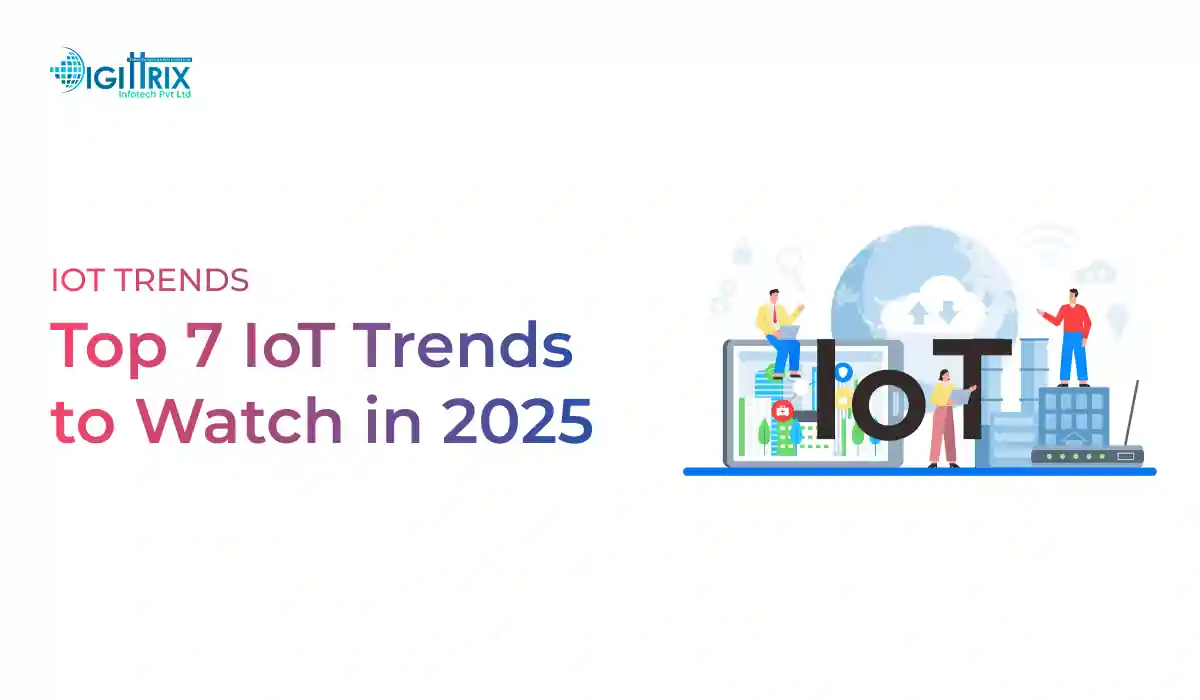By 2025, the IoT market is set to reach $1.6 trillion, supporting smarter homes, industries, healthcare, cities and transport systems globally.
Highlights
With Over 14 years of Experience in the IT Field, Helping Companies Optimise there Products for more Conversions

The Internet of Things (IoT) is transforming how Australians live and work. Increasingly connected devices are becoming part of daily life, helping IoT grow rapidly. From smart homes to wearable devices and industrial automation, IoT is expected to deliver more practical applications by 2025. Companies that embrace emerging trends will be more likely to succeed in the fast-evolving tech industry.
This article explores seven key topics shaping the future of IoT in 2025, drawing on market trends and research from groups like McKinsey and Gartner. It discusses how IoT app developers can prepare to adapt. The insights offered are valuable to companies, startups, and developers. Statista reports show that 75.4 billion IoT devices will be active worldwide by 2025 across industries and smart homes.
Looking for the best IoT partner? Check Digittrix's expert guide to choose the right one!
Edge computing has been around for some time, but its true potential in IoT is only just starting to be recognised. Devices now handle data locally instead of relying on the cloud. This change reduces delays and increases the speed of system responses. It plays a vital role in industries such as automotive and manufacturing, where slow data processing can threaten safety and efficiency.
This change enhances the performance of IoT mobile apps in scenarios where immediate feedback is essential, such as industrial monitoring or telemedicine. Developers focusing on custom app development now need to create systems that operate in hybrid configurations. In these setups, edge devices manage critical tasks while connecting to the cloud only when required.
The industry continues to grow in this sector. Gartner predicts that by 2025, 75% of enterprise-managed data will rely on edge computing.
Security remains a significant concern in the IoT landscape. More connected devices increase the risks associated with weak device security. Hackers are exploiting vulnerabilities such as outdated software, unprotected data channels and weak security systems.
Developers offering mobile app development services must design platforms with multiple layers of security. This involves implementing methods like two-factor authentication, encrypted storage, and secure APIs. In industries, it's crucial to protect the sensors and controllers connected to production systems.
McKinsey emphasises that security concerns remain a major barrier to deploying IoT in both consumer devices and industrial environments. Companies developing IoT solutions need to prioritise cybersecurity, incorporate regular updates, and educate users on how to stay protected.
By 2025, artificial intelligence will team up with IoT systems to create smarter tools that do more than just automate tasks. AI learns from data gathered by IoT sensors and suggests changes or actions to boost how systems perform. This approach is common in areas like healthcare, shipping, and manufacturing.
Smart machines in factories can forecast when maintenance is required and reduce downtime. In the automotive industry, AI assists by analysing driving behaviours and alerting drivers to unusual actions or potential wear and tear. These are practical ways IoT mobile apps provide people with useful updates and suggestions based on their environment.
This progress introduces new responsibilities for companies developing IoT applications. They must create tools that handle large volumes of data while displaying AI alerts through user-friendly layouts. Teams need to plan carefully and conduct thorough testing. It also opens the door for on-demand app development customised for predictive health systems or equipment monitoring.
Smart cities are becoming a reality. Governments and companies around Australia and the world are investing in sensors, automation, and smart grids. These technologies aim to improve traffic management, energy use, waste handling, and safety.
Connected infrastructure is leading in IoT app development. App developers contribute by creating tools that assist officials or locals in tracking utilities, managing traffic systems, or reporting issues. By 2025, cities are expected to adopt IoT in urban planning to save money and better meet public needs.
Gartner estimates that more than 500 smart city initiatives will be launched globally by the end of 2025. These initiatives require customised app development to comply with government regulations and support millions. Gartner predicts that 80% of new cars by 2025 will feature IoT functions like tracking, sensors, and diagnostics.
Wearable technology is expanding into areas beyond fitness. In healthcare, wearables now monitor heart rates, oxygen levels, sleep, and stress. They connect with IoT mobile apps, enabling medical professionals and users to utilise real-time data for more informed decisions.
Wearable devices now extend beyond personal health and are becoming tools to keep workers safe in industrial settings. In areas such as construction or manufacturing, smart helmets measure factors like worker fatigue or environmental changes.
Creating apps for wearables is evolving into developing systems that convert sensor data into clear and practical information. Developers also need to consider the following health and security guidelines while ensuring privacy and data regulations are upheld.
Smart mobility will grow with connected cars and automotive IoT. These vehicles communicate with each other, traffic systems, and cloud networks to make travel safer and more efficient. Apps developed for this purpose can manage routes, perform diagnostics, and send updates about repairs or road issues.
This shift is spreading worldwide as electric and self-driving cars become more common. Developers and companies working to create IoT apps will find new opportunities in the automotive industry. Programs that rely on live data from car sensors need to load quickly and operate effectively.
Developing mobile apps will require support for GPS tracking, voice commands, and secure data sharing. Experts predict that by 2025, over 80% of new cars will connect to the internet. This trend indicates that the demand for related applications is growing rapidly.
More people and industries are focusing on reducing harm to the environment. Predictions suggest that businesses will adopt IoT tools by 2025 to decrease energy use, better manage waste, and monitor their carbon emissions. Smart devices like air quality monitors, energy meters, and irrigation systems will become widespread in both cities and rural areas.
These systems help people monitor environmental performance through IoT mobile apps. For instance, a building manager can get alerts about energy or water wastage. Companies specialising in custom app development are now building tools to aid their clients in tracking these metrics.
Research groups like Gartner forecast rapid growth in sustainability-focused technologies soon. This change encourages app developers to learn more about environmental data formats, energy efficiency targets, and resource-related societal issues. Forbes states that 70% of businesses will adopt IoT by 2025 to improve operations and cut manual work.
Exploring IoT solutions? Check Digittrix's curated list of leading IoT app developers in India!
IoT continues to grow across major industries. Opportunities in sectors like automotive, manufacturing, smart homes, and consumer wearables are increasing. Developers, business owners, and startups need to understand these new IoT trends to plan future projects that meet user demands and market needs.
IoT app development companies now play a more crucial role than ever. Clients want more than just apps; they need systems that can manage data, operate effectively, and provide reliable performance. Businesses offering mobile app development services focused on practicality and adaptability will lead the next wave of technological advances.
By 2025, these emerging technologies will shape how businesses meet customer needs, how cities operate, and how people connect with their environment. Keeping up with current trends and concentrating on these areas is essential for both developers and companies to remain relevant and competitive in the global technology scene.
As IoT trends evolve in 2025, businesses are embracing smarter systems—from AI integration and edge computing to smart mobility and sustainable solutions. Staying current with these developments means having robust IoT applications that connect devices, automate tasks, and deliver real-time data.
At Digittrix, we specialize in custom IoT app development for startups, SMEs, and enterprises. With over 14 years of experience, our team builds reliable, scalable, and secure apps tailored to today’s IoT demands.
Whether it’s mobile apps for connected devices or cloud platforms for monitoring and control, we deliver solutions that align with emerging IoT technologies.
Ready to build a future-focused IoT app? Contact us at +91 8727000867 or digittrix@gmail.com

Do you need help in Mobile App development?




Join over 1500+ businesses we've already helped!
Key IoT trends expected in 2025 include using edge computing, combining AI with IoT, improving security, building smarter cities, advancing wearable devices, connecting vehicles to networks, and creating sustainable technologies.
IoT gadgets work with private information. Using encryption, verifying identities, and designing secure APIs is necessary to guard them from cyber risks.
AI helps IoT systems process information, find problems before they occur, and handle tasks on their own. This makes them more capable across areas such as health care and factories.
Many industries see gains from IoT, including automotive, agriculture, healthcare, logistics, manufacturing, and urban planning. It allows them to automate processes and make decisions using data.

©2025Digittrix Infotech Private Limited , All rights reserved.